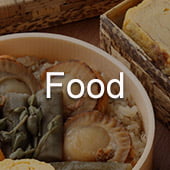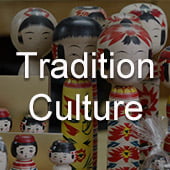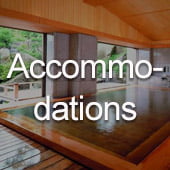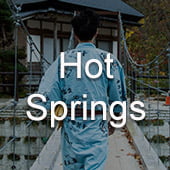Tsugaru Ichidai-sama
At the beginning of a new year, many people in Japan go to hatsumode (New Year’s visit to shrines and temples) to pray for a healthy new year. It is common to visit a shrine or temple to pray to the local deity or a specific deity to make a wish. In Tsugaru, however, the custom of “Tsugaru Ichidai-sama,” has been widely practiced since the era of the feudal government. This unique custom involves the visitation of shrines and temples that houses the guardian deity of the zodiac sign of the year of one’s birth. People visit the shrine “Tsugaru Ichidai-sama” to pray for the guardian deity of the zodiac sign of the year of their birth not only during the New Year’s holidays, but also at other milestones in life such as entrance exams, employment and birth of a child.
When you visit Tsugaru, please stop by the shrine of your or your family’s zodiac sign to bring you luck.
Year of the Rat
Taga Shrine
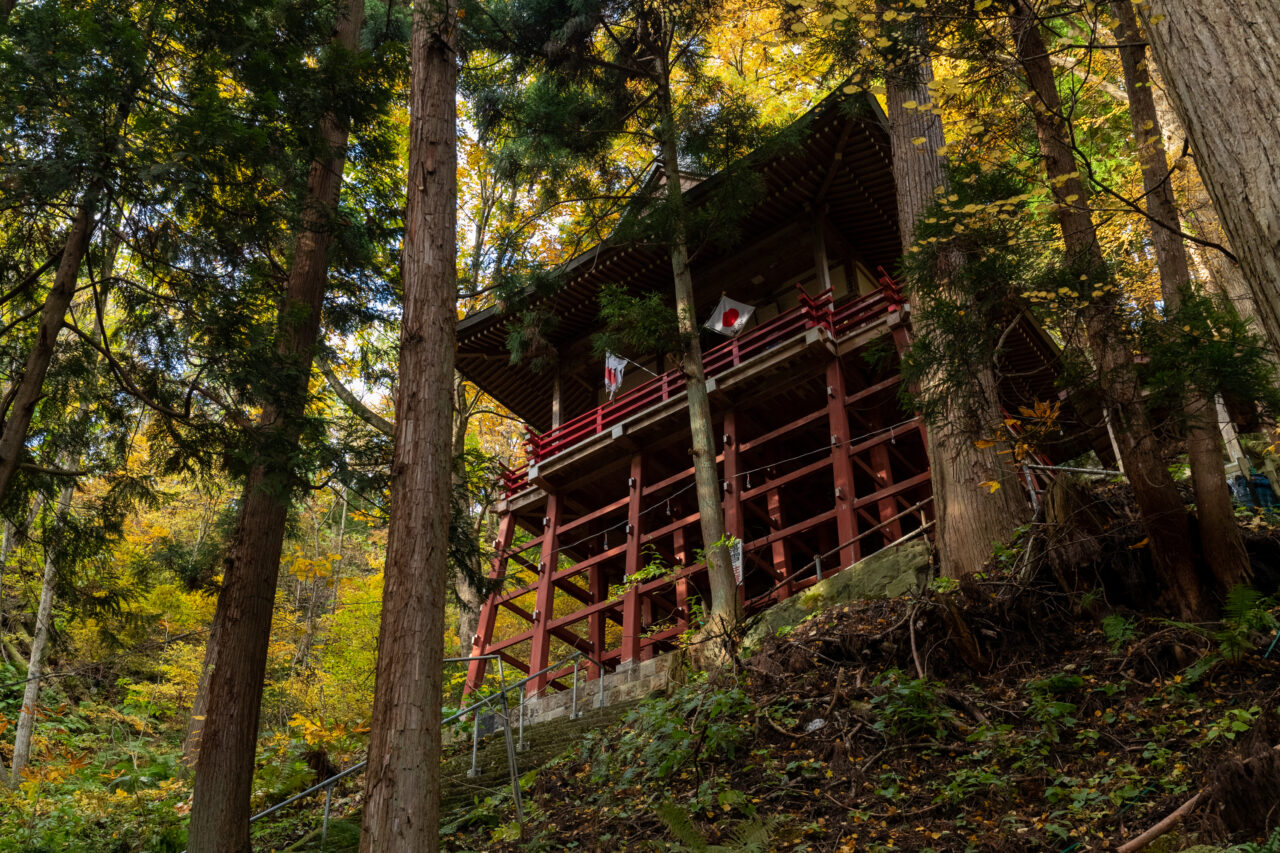
The Ichidai-sama of the year of rat is in Taga Shrine, located in the Higashimeya area of Hirosaki city in Aomori. Based on one of the theories of its origin, Taga Shrine was built in 731 by Gyoki, a monk who spread Buddhism among the common people. The second theory claims that it was built by Sakanoue no Tamuramaro in 807.
To reach Taga Shrine, visitors have two scenic options. Visitors can climb the elegant stone-paved steps and continue further up the steep stone steps, or take the walking path that bypasses the steep steps. Either route offers great views to and from the shrine.
At the top of the stairs is the main hall of Taga Shrine, which is said to have been modeled after Kiyomizu Temple in Kyoto. For this reason and because spring water flows from the main hall, Taga Shrine is also known as “Kiyomizu Kannon.”
| Temple/Shrine Name | Taga Shrine |
|---|---|
| Zodiac | Rat |
| Common Name | Meya no Kiyomizu Kannon |
| Principal Image | Senju Kannon Bosatsu |
| Enshrined Deity | Izanagi no Mikoto |
| Blessings | Marital bliss, children, easy birth, matchmaking, healing of illness, good health, good harvest, and repelling evil spirits |
| Address | 948 Sotoyama Sakuraba Hirosaki Aomori 036-1441 |
| Access |
|
| Contact | TEL 0172-86-2952 |
| URL | https://twitter.com/kiyomizu_taga |
| Festival Dates | August 17th |
Year of the Ox and the Tiger
Gumonji
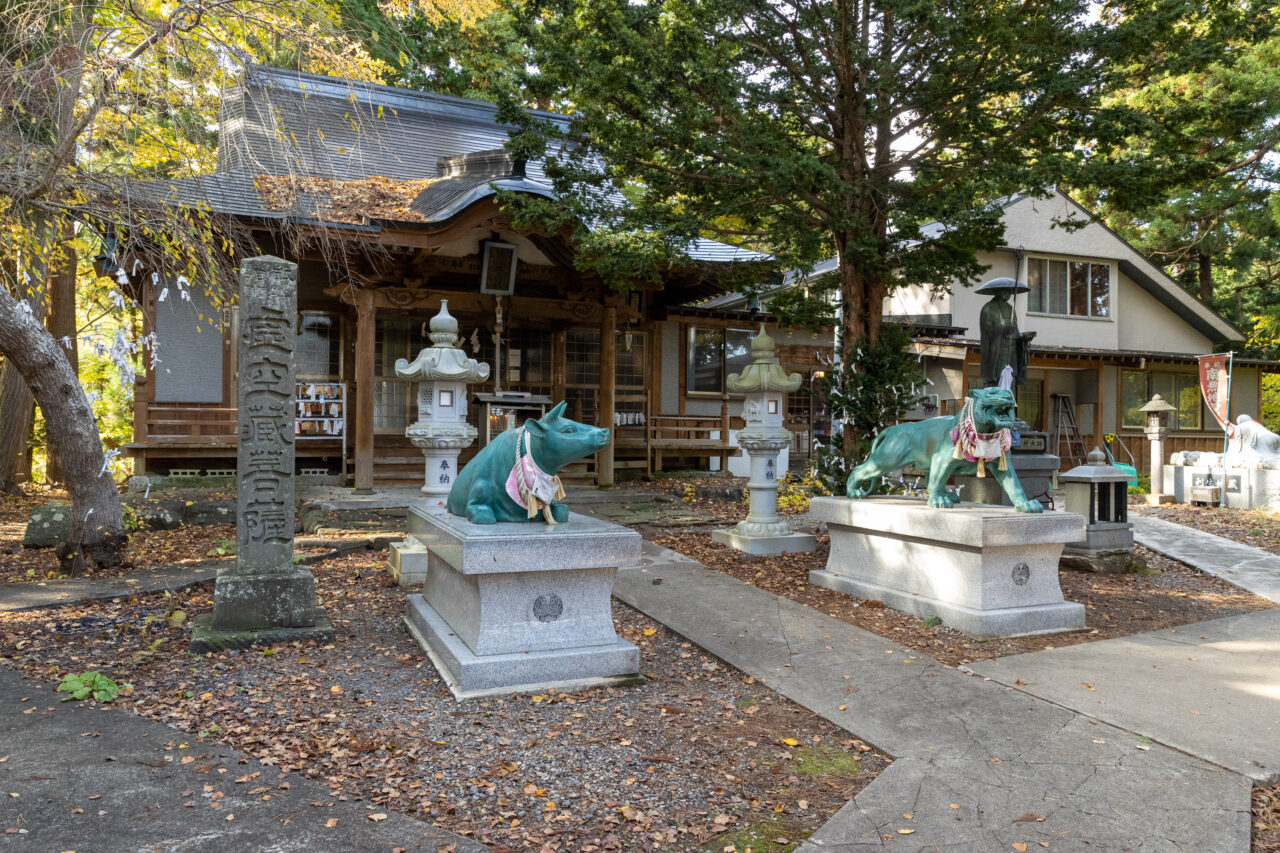
The Ichidai-sama of the year of the Ox and the year of the Tiger is located at Gumonji in the Hyakuzawa district of Hirosaki, Aomori. Gumonji is located near the Iwakiyama Shrine. Climb the stone steps and pass through the forest to reach the temple. In the temple grounds, you will be greeted by a statue of an ox on the left and a tiger on the right.
It is believed that the temple was built in 1629 by Nobuhira, the second lord of Tsugaru clan, after going through the Shingon sect of Buddhism’s intense and painful practice of “gumonjiho.” He wished for the peace of his clan and territory in the face of continuous strife, earthquakes, and famine.
The temple grounds house one of the largest bells in Aomori Prefecture, and visitors are welcome to ring it when they visit.
| Temple/Shrine Name | Gumonji |
|---|---|
| Zodiac | Ox/Tiger |
| Common Name | Hyakuzawa no Kokūzō -sama |
| Principal Image | Kokūzō Bosatsu |
| Enshrined Deity | None |
| Blessings | Good fortune, matchmaking |
| Address | 29 Terasawa Hyakuzawa Hirosaki 036-1343 |
| Access |
|
| Contact | TEL 0172-83-2373 |
| URL | – |
| Festival Dates |
|
Year of the Rabbit
There are four Ichidai-sama born in the year of rabbit in Tsugaru.
Saishoin
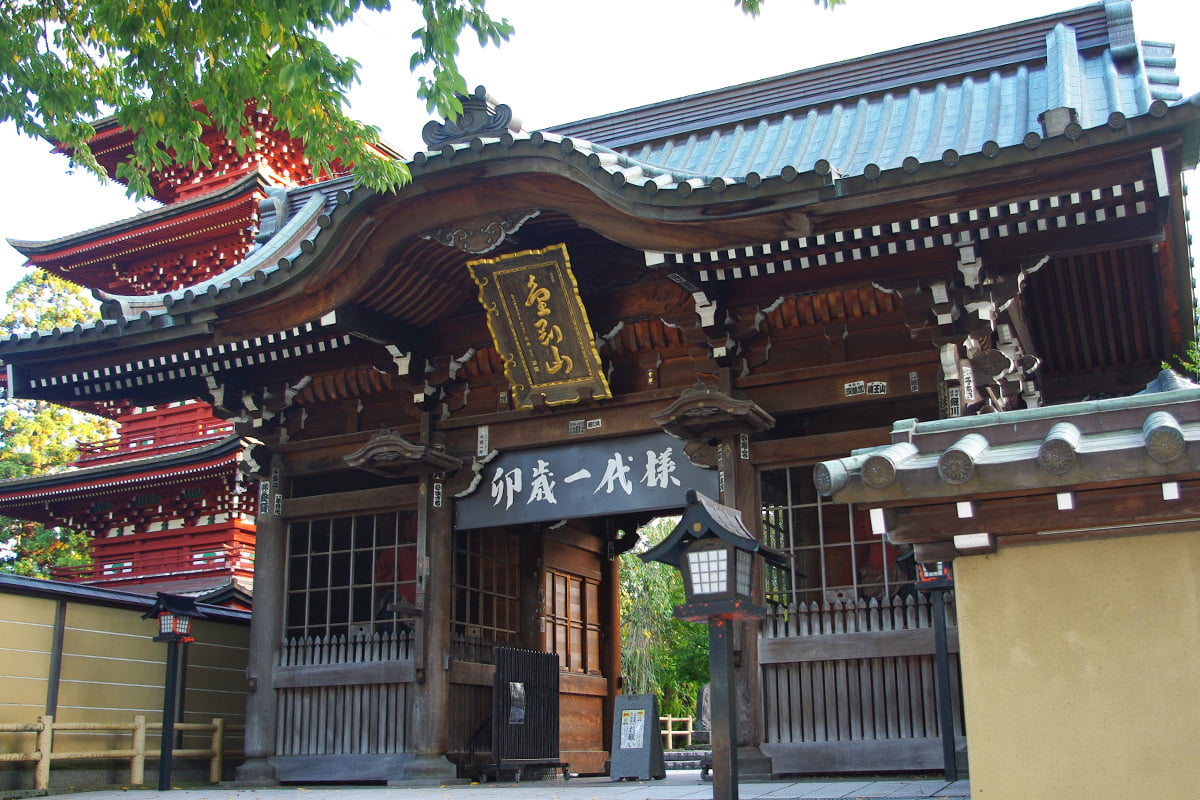
The first Ichidai-sama born in the Year of the Rabbit is located in Saishōin Temple in the town of Doya, Hirosaki, Aomori Prefecture. It is the most prestigious temple in the Tsugaru region, and is a regular place for local people to pay their new year visit.
Monju Bosatsu was transferred from Mt. Koya, a sacred site of Buddhism in Japan, and has been worshipped as a guardian of wisdom by the feudal lords of Tsugaru for generations.
The symbol of the temple is the five-story pagoda (Goju-no-to), which is designated as a national important cultural property and said to be the most beautiful pagoda in Tohoku.
| Temple/Shrine Name | Saishōin Temple |
|---|---|
| Zodiac | Rabbit |
| Common Name | Saishōin no Monju-sama |
| Principal Image | Monju Bosatsu |
| Enshrined Deity | None |
| Blessings | Academic achievement, success in exams, employment, matchmaking, good harvest, national peace |
| Address | 63 Doyamachi Hirosaki 036-8196 |
| Access |
|
| Contact |
|
| URL | http://www15.plala.or.jp/SAISYOU/index.html |
| Festival Dates | Lunar Calendar June 13 |
Tenmangu
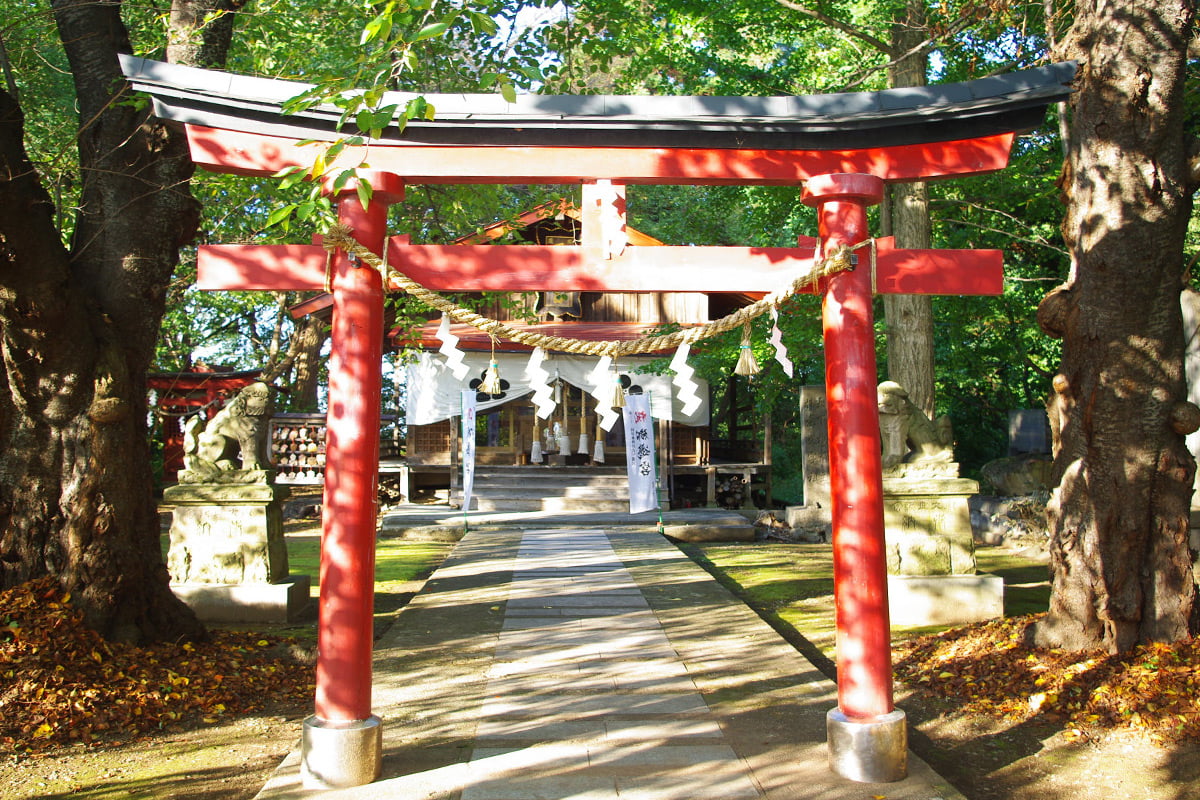
The second shrine for the year of the rabbit is Tenmangu, located in Nishimomori, Hirosaki, Aomori Prefecture. It is located in a secluded area at the top of the Jogenji hill, with a view of Mount Iwaki from its grounds.
It was originally a temple called Daikoin, which was opened by Tamenobu, the feudal lord of Tsugaru. He invited a man from Echigo (Niigata Prefecture) named Eison Daikoin, who was in a position to control the religious leaders called “Yamabushi” in Tsugaru. He opened the temple for the general public to visit and make requests to the gods and Buddha. During the Meiji period (1868-1912), Daikoin was abolished due to a government order to make a distinction between Shinto and Buddhism, and a deity was hastily transferred from the temple Atago-yama Kyōunji (Iwaki) and renamed Tenmangu. Both the deity and the principal image of the shrine are deities of wisdom, and the shrine has been a popular place for students to pray for success in entrance examinations.
The weeping cherry tree on the temple grounds is estimated to be over 500 years old and is designated as a natural monument by the prefecture.
| Temple/Shrine Name | Tenmangu |
|---|---|
| Zodiac | Rabbit |
| Common Name | Shigemori no Tenmangu |
| Principal Image | Monju Bosatsu |
| Enshrined Deity | Tenjin |
| Blessings | Academic achievement |
| Address | 1-1-34 Nishishigemori Hirosaki 036-8273 (Shrine office) |
| Access |
|
| Contact | TEL 0172-32-5796 |
| URL | – |
| Festival Dates | June 25 Annual Festival |
Kanehira Tenmangu

The third Ichiyo-sama born in the year of the rabbit is Kanehira Tenmangu in Hirosaki, Aomori Prefecture. This respected shrine has deep roots in the Kanehira area and is well known to locals.
Kanehira Tenmangu is said to have been moved to its present location from Tomisakae in Hirosaki by Sakon Kanehira, a samurai, during the Koan era (1278-1287), and was visited by many ascetic practitioners over the generations. In 1603, Tamenobu, the feudal lord of Tsugaru, rebuilt the shrine, repairing the shrine pavilions, and prayed for the repelling of bad illnesses. In 1645, Nobuyoshi, the third lord of the Tsugaru clan, built a Kaguraden, a place for offering songs and dances to the gods.
In addition to the guardian dogs built in 1773, there are four stone monuments built in the late Kamakura period (1185-1333) for memorial services for the dead, inscribed with characters representing Buddha and Bosatsu.
| Temple/Shrine Name | Kanehira Tenmangu |
|---|---|
| Zodiac | Rabbit |
| Common Name | Kanehira no Tenjin-sama |
| Principal Image | Monju Bosatsu |
| Enshrined Deity | Michizane Sugawara |
| Blessings | Academic achievement, success in exams, repelling bad illnesses |
| Address | 106 Yamashitahayashizoe Kanehira Hirosaki, Aomori 036-1332 |
| Access |
|
| Contact | – |
| URL | – |
| Festival Dates | April 25 (2022) Annual Festival |
Kongōji
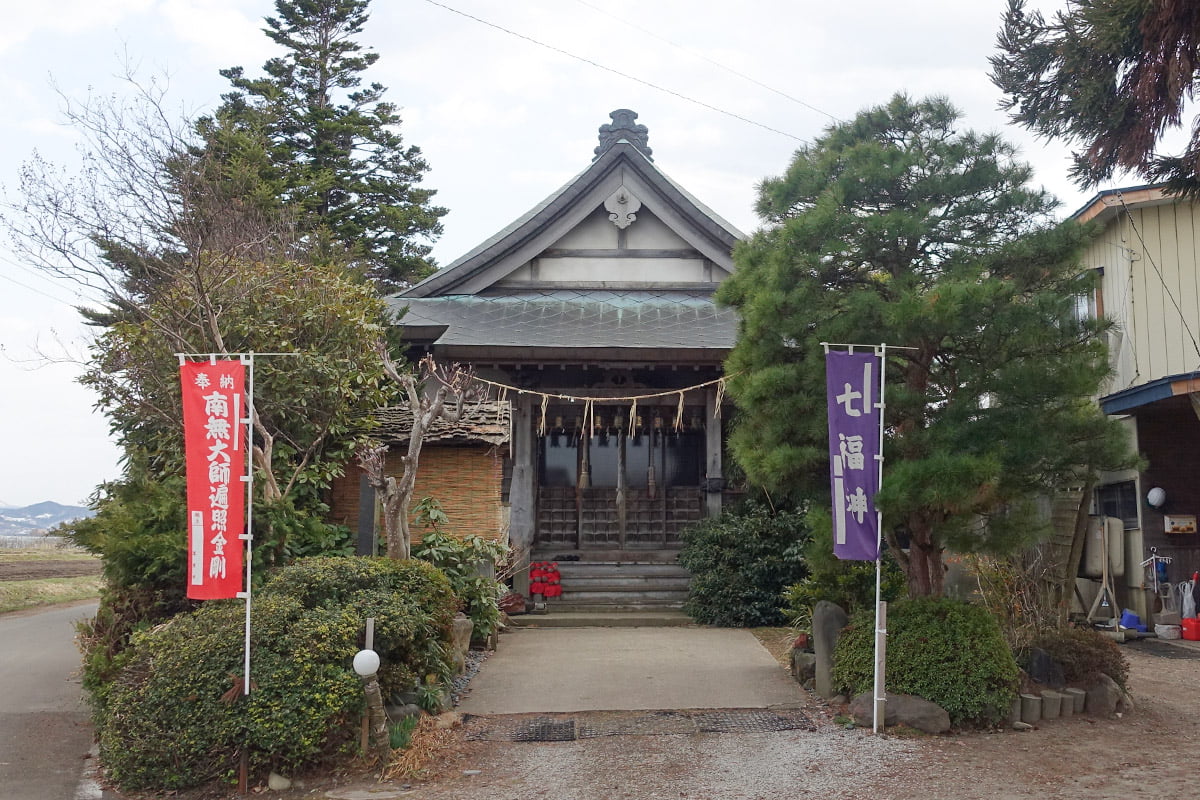
The fourth temple of Ichidai-sama born in the year of the Rabbit is Kongōji in Hirakawa, Aomori Prefecture. The temple is located in Akakura, at the foot of Mount Iwaki, where the structures of Ichidai-dō, Godai-dō, and Daishi-dō are built around a training hall. It is said that demons have lived in Akakura since ancient times, and the people of Tsugaru have worshipped them as gods.
The temple was founded by the first chief priest, Terumasa Makita, who was told by a white-haired old man riding a dragon in a dream that he should build a grave in Akakura.
On the third Sunday of June every year, a ceremony called “kasho zammai” is held. At the end of the ceremony, visitors walk across the fire to pray for a bountiful harvest and good health.
| Temple/Shrine Name | Kongōji |
|---|---|
| Zodiac | Rabbit |
| Common Name | – |
| Principal Image | Monju Bosatsu |
| Enshrined Deity | – |
| Blessings | Good harvest, prosperity, good luck, maritime safety, family safety |
| Address | 141 Miyamoto Yawatasaki Hirakawa Aomori 036-0241 |
| Access |
|
| Contact | TEL 0172-57-2548 |
| URL | https://kongoji.net/ |
| Festival Dates | Third Sunday of June Kasho-zanmai |
Year of the Dragon and the Snake
Mt. Atago Kyōunji
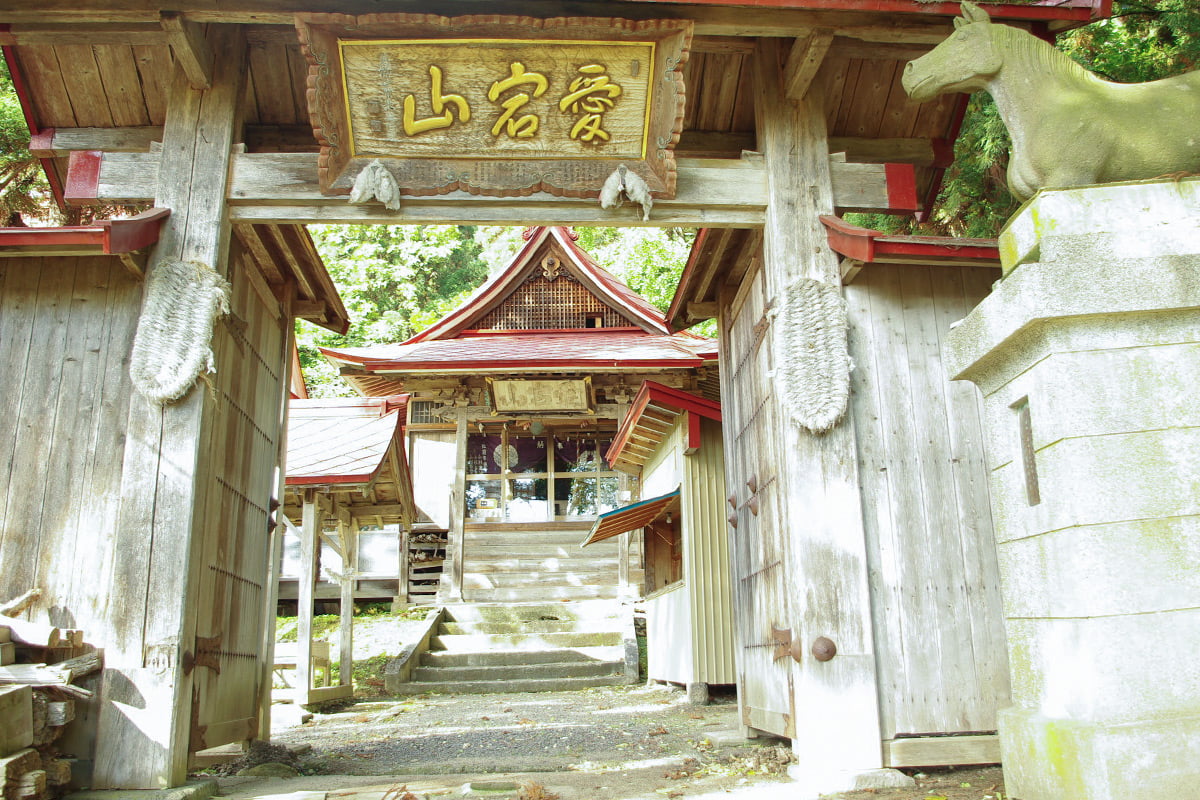
The Ichidai-sama of the year of the dragon and the year of the snake is located in the Kyōunji, located in the Atago district of Hirosaki, Aomori Prefecture. Located on Mt. Atago, which has been selected by the locals to have one of the ten best views of Tsugaru, the temple offers a panoramic view of the Tsugaru Plain atop a steep flight of stairs.
The main jizo statue, Shogun Jizo, is said to have been worshipped by Tamenobu, the feudal lord of Tsugaru. Before leading an attack on Ogaki Castle in Gifu Prefecture during the Battle of Sekigahara, Tamenobu prayed to the local deity, Atago-sama. After the victorious battle, he requested the jizo statue to be moved to its current location. This Shogun Jizo is a reincarnation of Fugen Bosatsu and is believed to bring blessings for good deeds and for fire prevention.
| Temple/Shrine Name | Mt. Atago Kyōunji |
|---|---|
| Zodiac | Dragon/Snake |
| Common Name | Atago-sama |
| Principal Image | Shogun Jizo-son |
| Enshrined Deity | None |
| Blessings | Good deeds, fire prevention |
| Address | 63 Yamashita Atago Hirosaki 036-1302 |
| Access |
|
| Contact | TEL 0172-82-3429 |
| URL | – |
| Festival Dates | Lunar Calendar June 23-24 Summer Annual Festival |
Year of the Horse
Shirayamahime Shrine
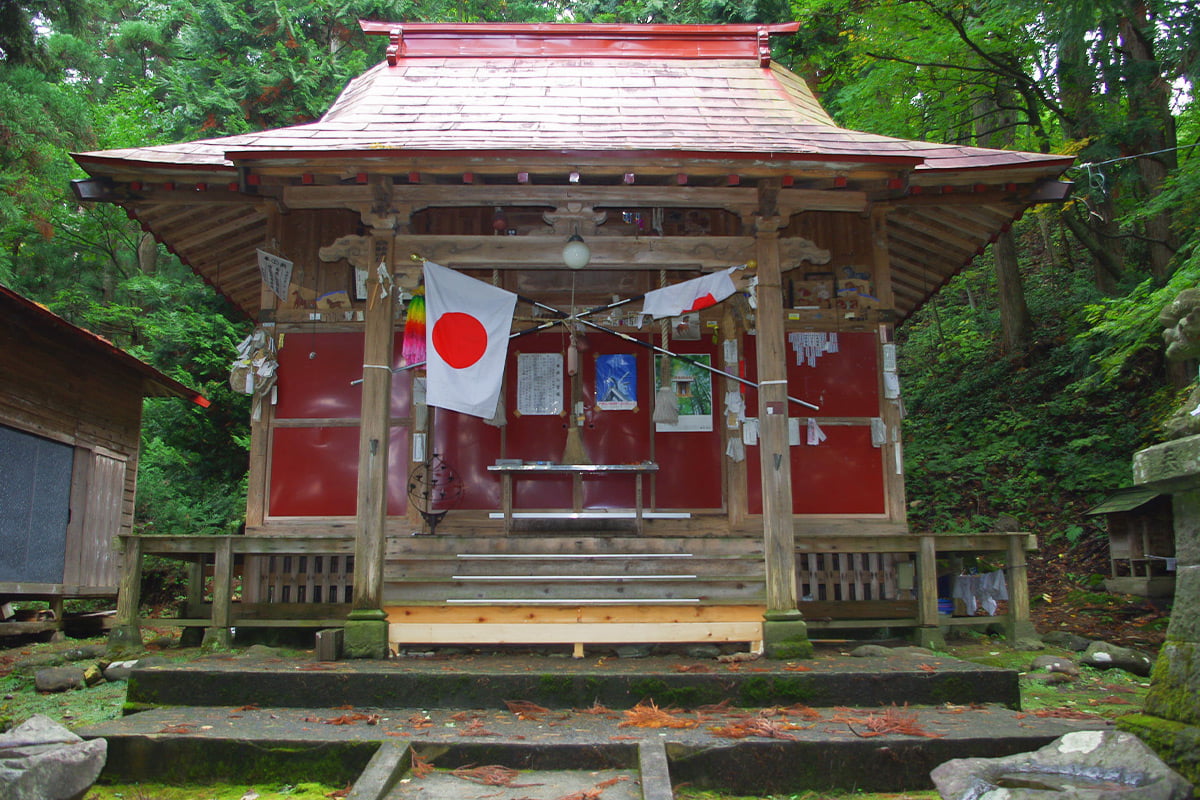
The Ichidai-sama of the year of the horse is in the Shirayamahime Shrine located in Fukuro, Kuroishi City, Aomori Prefecture. The ascent to the shrine grounds is long and steep, and wooden canes are provided at the entrance for assistance.
Originally a temple, it is said that when Sakanoue no Tamuramaro attacked the east, he put a portrait of Seishi Bosatsu in a bag and hung it on a branch of a large tree to pray for good luck on the battlefield. He built a hall to thank the gods when the battle was successful. The shrine declined when Asaseishi Castle fell, but was rebuilt by the local residents and later renamed Shirayamahime Shrine to distinguish between Shinto and Buddhism.
After passing through the torii gate, there is a large ginkgo tree on the left side, estimated to be four to five hundred years old and designated as a natural monument of Kuroishi City.
| Temple/Shrine Name | Shirayamahime Shrine |
|---|---|
| Zodiac | Horse |
| Common Name | Fukuro no Kannon-do |
| Principal Image | Seishi Bosatsu |
| Enshrined Deity | Izanami no Mikoto, Kukurihime no Mikoto |
| Blessings | Crime forgiveness, eternal youth and longevity |
| Address | 112 Tomioka Fukuro Kuroishi 036-0412 |
| Access |
|
| Contact | TEL 0172-52-5516(Haguro Shrine) |
| URL | – |
| Festival Dates | Luna Calendar June 23 |
Year of the Sheep and the Monkey
Daienji

The Ichidai-sama of the year of the sheep and the year of the monkey is Daienji Temple, located in Owani, Aomori Prefecture. The temple is known to locals in Tsugaru as “Dainichi-sama of Owani”.
Dainichi-sama, the principal image of the temple, is 4.85 meters high, designated as a national important cultural property. It is said to be the oldest Buddha image in the Tsugaru area. The Buddha image itself is not actually a Dainichi Nyorai, but a seated Amida Nyorai. Typically, cypress is used for Buddhist statues, but the “Dainichi-sama” is made of cypress.
There is a theory that the name of the town “Owani” evolved from “Oh-amida” (large Amida) to “Owani.”
| Temple/Shrine Name | Daienji |
|---|---|
| Zodiac | Sheep/Monkey |
| Common Name | Dainichi-sama of Owani |
| Principal Image | Dainichi Nyorai |
| Enshrined Deity | None |
| Blessings | Healing of illness, peaceful life, wish fulfillment |
| Address | 12 Muraoka Kuradate Owani 038-0212 |
| Access |
|
| Contact | TEL 0172-48-2017 |
| URL | – |
| Festival Dates |
|
Year of the Rooster
Kokujōji Temple

The Ichidai-sama of the year of the rooster, is located at Kokujōji Temple in Ikarigaseki, Hirakawa, Aomori Prefecture.
It is said that the temple was built in Ajarayama located in Owani and Hirakawa by the order of Shotoku Taishi during the reign of Emperor Suiko. Later, it was renamed Kogageyama Fudōin Kokujōji Temple of the Tsugaru clan and became a place for the Tsugaru clan to make wishes.
The temple’s Fudō myō-ō, called “Nemari Fudo” because of its seated position, is one of the three Tsugaru Fudō statues, along with Rokugo Nagaisawa (Kuroishi) and Nakano Shrine (Kuroishi), and legend has it that all three statues were made from a single tree. The statue is believed to sweat to signal a bad omen, and is also known as the “Asekaki Fudō” (the sweating Fudō). Whenever the statue sweated, the feudal clan would order them to pray by burning small pieces of wood.
| Temple/Shrine Name | Kokujōji |
|---|---|
| Zodiac | Rooster |
| Common Name | Kogake no Ofudō-sama |
| Principal Image | Fudō myō-ō |
| Enshrined Deity | None |
| Blessings | Disaster prevention |
| Address | 1-1 Monzen Ikarigasekikogake Hirakawa 038-0102 |
| Access |
|
| Contact | TEL 0172-45-2446 |
| URL | – |
| Festival Dates |
|
The Year of the Dog and Boar
Hirosaki Hachimangu
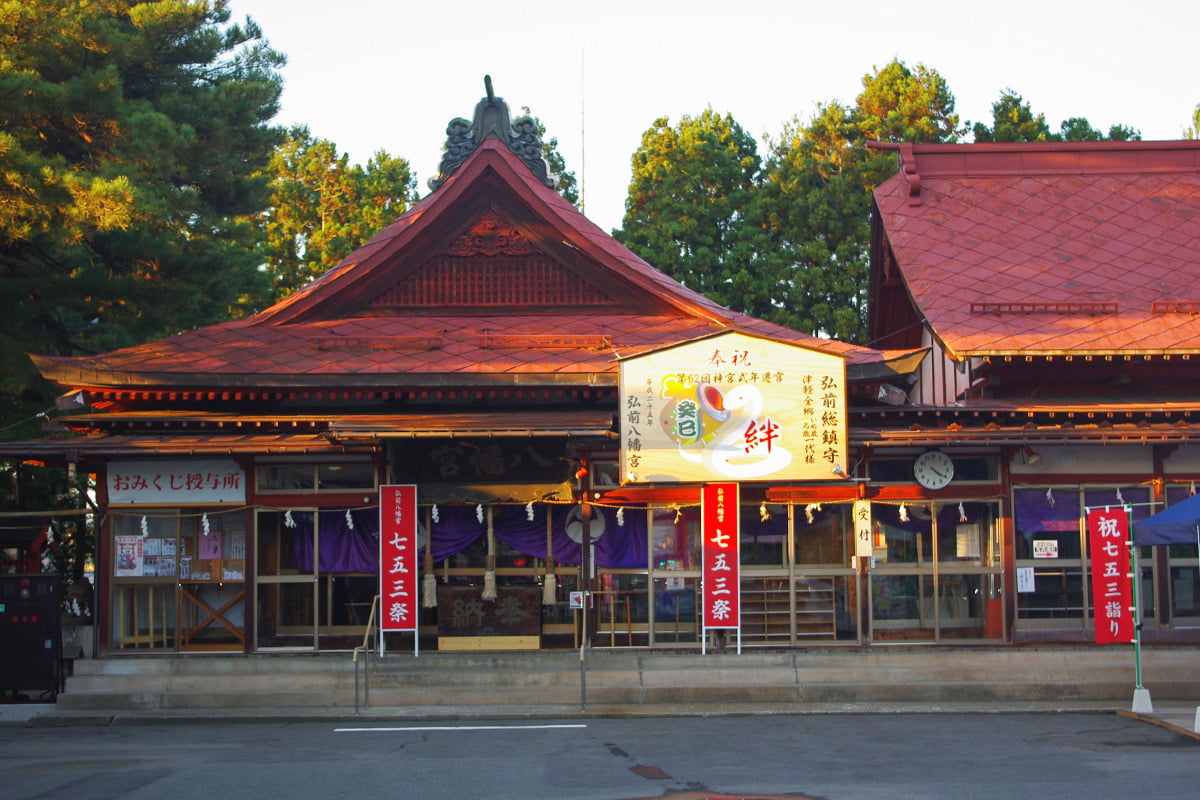
The Ichidai-sama of the year of the dog or the year of the boar is Hirosaki Hachimangu, located in Hachiman-cho, Hirosaki, Aomori Prefecture. It is widely known in the Tsugaru region as “Hirosaki no Hachiman-sama” and is visited by many people during the new year holidays.
The Hachimangu was once located in Hachiman (formerly Iwaki) to protect Oura Castle, but in 1612, Nobuhira, the second lord of Tsugaru, moved it to its current location to guard the weak point of the Hirosaki Castle.
The main hall and the Karamon gate are representative of the Momoyama period style of shrine architecture, and are designated as National Treasures.
| Temple/Shrine Name | Hirosaki Hachimangu |
|---|---|
| Zodiac | Dog/Boar |
| Common Name | Hirosaki no Hachiman-sama |
| Principal Image | Hachimandai Bosatsu |
| Enshrined Deity | Homuttawake no Mikoto, Hachiman Ookami, Okinagatarashihime no Mikoto, Hime Ookami |
| Blessings | Family safety and health, easy birth, success in exams, success in competition, success in business, business prosperity, healing of illnesses |
| Address | 1-1-1 Hachimancho Hirosaki Aomori 036-8057 |
| Access |
|
| Contact | TEL 0172-32-8719 |
| URL | https://hirosaki-hachimangu.com/ https://www.instagram.com/hirosakihachimangu/ |
| Festival Dates | August 1 Annual Festival |
Others
There is also a temple where all Tsugaru Ichidai-sama are enshrined. If you want to visit many temples but simply do not have time, how about visiting this one?
Jinguji Temple

Jinguji Temple is the home for all Tsugaru Ichidai-sama, located at Saruka Shrine in Hirakawa, Aomori Prefecture. It is a perfect place for families and groups to pay a visit, as it is possible to visit all the Tsugaru Ichidai-sama at once, even if they belong to different signs of the zodiac. Locals often visit Jinguji Temple with their families first, and then visit the temple or shrine for their specific zodiac sign.
Jinguji Temple once managed twelve temples located within the precincts of the Saruka Shrine. Although it was rebuilt by Tamenobu, the lord of the Tsugaru clan, as a temple where people could make requests to the gods and Buddha, eight of the temples were destroyed and the priests banished due to the conflict with the Nanbu family. Later, the temple was rebuilt by Nobuhira, the second lord of the Tsugaru clan, to pray for the safety of the Tsugaru clan. However, due to the Meiji government’s order to distinguish between Shinto and Buddhism, only two of the four remaining temples remained, and one of them took over the name of Jinguji Temple, which is still in use to this day.
In front of the Tsugaru Ichidai-sama, an ogre is enshrined seated in front of the temple, wishing to dispel evil diseases. A red torii gate, typically only found at shrines, stands at the altar of this temple.
| Temple/Shrine Name | Jinguji Temple |
|---|---|
| Zodiac | ALL |
| Common Name | – |
| Principal Image | ALL |
| Enshrined Deity | None |
| Blessings | ALL |
| Address | 166-2 Ishbayashi Saruka Hirakawa Aomori 036-0242 |
| Access |
|
| Contact | TEL 0172-57-3182 |
| URL | – |
| Festival Dates | – |

